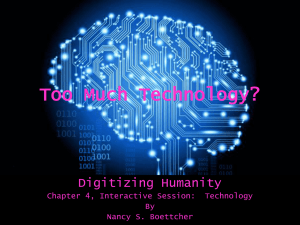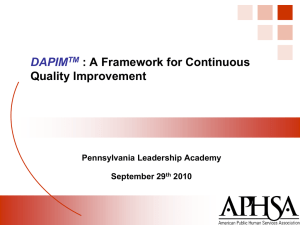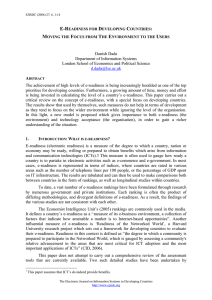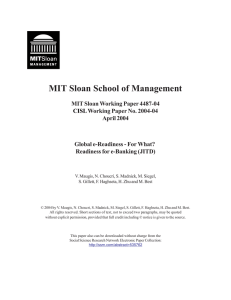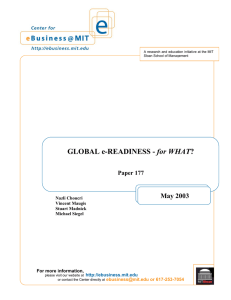e-Readiness - ABPMP – Saudi Chapter
advertisement
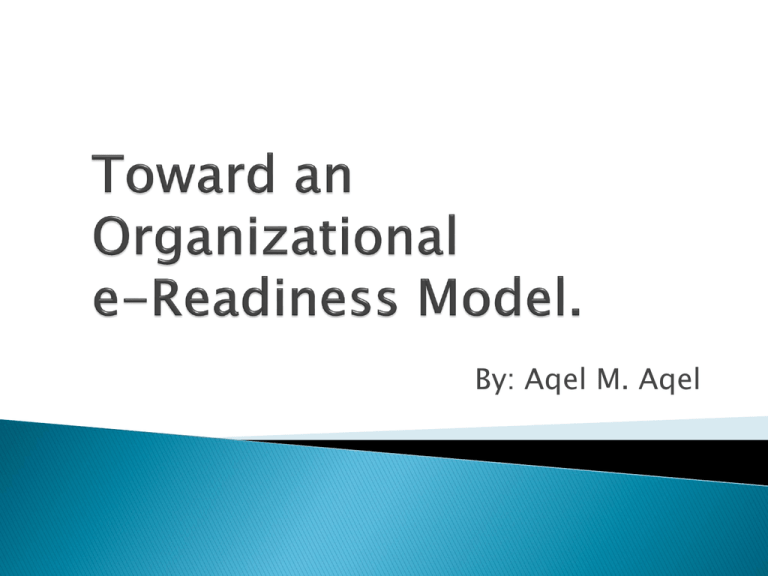
By: Aqel M. Aqel أقرأ باسم ربك الذي خلق 1خلق اإلنسان من علق اقرأ وربك األكرم 3الذي علم بالق لم علم اإلنسان ما لم يعلم صدق اهلل العظيم 5 4 2 Measuring Business Process Maturity while assessing organizational readiness for organizational e-transformation. Illustrates a proposed comprehensive model for assessing organizational readiness including business process criteria in addition to other organizational e-readiness billers (strategy, info technology, IT Security and ability to change). Introduction: Towards A Unified Organizational Readiness Model: ◦ E-Transformation Concept (Technology Enabled Government / TGovernment) ◦ Importance Of E-Transformation ◦ Need For Readiness Model Model Components (Includes Business Process Readiness) Business Process Readiness Criteria (Illustration And How To Measure) ◦ Inter-Agencies Processes ◦ National Level Business Process Management Bureau (NBPMB) ◦ ◦ Closure ◦ Quick summary for our lecture ◦ Conclusion (adopting national readiness model, and national level NBPMB) ◦ E-Transformation Concept: Technology Enabled Government / T-Government ◦ Importance Of E-Transformation ◦ Need For Readiness Model E-Transformation: Opportunities and Barriers • Total Dependency on IT • IT Impacts on Societies: – – – – Politically Economically Socially Service delivery • Managerial revolution is running parallel with IT revolution. • Information / Knowledge societies E-Transformation: Opportunities and Barriers What is e-Transformation: ◦ The process of transforming in to an innovative & effective IT-enabled organization is e-Transformation. Transformation levels: ◦ ◦ ◦ ◦ Government Agencies Private Sector Academic institutions Persons and societies E-Transformation: Opportunities and barriers • Barriers – Infrastructural – Financial – Organizational – Legislative – Security – Others E-Readiness Concept e-Readiness Criteria Method s Initiatives Existing Situation Audits Monitoring (Initiatives (projects Desired Situation Opportunities Limitations Infrastructure e-Services Training Change Management Barriers Using e-Readiness to facilitate organizational transformation Source: Aqel M. Aqal. Uncertainties E-Readiness Concept • e-Readiness is the generic capacity or aptitude of the public sector to use ICT for encapsulating public services and deploying to the public high quality information (explicit knowledge) and effective communication tools that support human development « [WPSR,2003, page 135]. Generic Capacity Use Information Technology Provide Information Provide Service Human Development E-Readiness Concept • Human Development – E- Government initiatives classification 2003) • Wasteful • Pointless • Meaningful (UN, E-Readiness Concept E-Readiness Levels 1. Global 2. Regional 3. National 4. Industries /Business Sectors 5. Organizational 6. Community 7. Personal e-Readiness levels Source: Aqel Industry Readiness Community & Personal Readiness Organizational Readiness National e-Readiness billers National eReadiness ◦ ◦ ◦ ◦ ◦ ◦ Figure 4.2: National e-Government Readiness Source: Author Telecom Banking Sector Academic Business Sectors Legal Individuals and Society Organizational E-Readiness • Answering the Question: – What preparations management should provide to digital era. • Org. Readiness depends: – – – – National e-gov model. Organization Role in national e-trans. Nature of relations with others. General maturity technically and managerially. Importance of e-readiness model • Using an e-readiness model: – Will Help formulating strategic plans based on identified needs. – Justify projects and its dependencies – Upgrading to higher levels of maturity – Unify criteria to assess and compare readiness Importance of e-readiness model • E-readiness criteria depends on ideal organization characterized in “learning organization”. • "learning organizations continuously learns through its members individually and collectively to create a sustainable competitive advantage by effectively managing internally and externally generated change" [Sudharatna & Li, 2007]. E-Readiness Concept Layers of readiness • Learning org. characteristics: 1. 2. 3. 4. 5. Cultural values Leadership Commitment and empowerment Communication, knowledge transfer Employee characteristics and performance upgrading Organizational e-Readiness Model Organizational E-Readiness Model 1. 2. 3. 4. 5. Strategy Readiness Business Process IT Infrastructure Org. Culture readiness (Ability to Change) IT Security Organizational e-Readiness 1- Strategy Organizational e-Readiness 1. Strategy • Strategic management and transformational leadership style are two key factors that contribute to the success of e-government initiatives [Wenbo, 2002] Organizational e-Readiness 1. Strategy • Public agencies with considerable goal ambiguity tend to have a difficult time strategizing and implementing management innovations. Wechsler et. al. 1997 Organizational e-Readiness 1. Strategy Strategy Readiness ◦ Ability for strategic planning ◦ Ability to strategic management 1. Organizational structure 2. Functions and services 3. Performance management 4. Informational Model Organizational e-Readiness 1. Strategy 1.1 Organizational Structure ◦ "Organizational structure is the way in which the interrelated groups of an organization are constructed. The main concerns are effective communication and coordination" [wikipedia, 2007] Managed OR mechanism Used effectively in HR Identify relationships and authorities Covers all activities including ICT Communicated and recognized Organizational structure is documented Organizational e-Readiness 1. Strategy 1.2 Functions and services ◦ What products and services we deliver in order to achieve our strategy. What Departments are doing What products and Services they are providing to: Individuals Small Businesses Corporates Other key stakeholders Organizational e-Readiness 1. Strategy 1.2 Functions and services ◦ Evaluate functions and services ◦ Are services satisfying and supporting business strategy ◦ Clear responsibilities ◦ Level of Automation ◦ Integration with HR incentive System 1.3 Performance management ◦ Performance management is "a systematic, integrated management approach that links enterprise strategy to core processes and activities. By providing planning, budgeting, analysis and reporting capabilities, performance management allows the business to be "run by the numbers" and measurement to drive management decisions." [wikipedia, 2007] ◦ Strategic planning can help in managing change through: linking agency strategies with performance measures". [Berry, 2007] ◦ "Monitoring progress made toward achieving program goals requires systematic measurement. ICT has facilitated the processing of unprecedented amounts of program data more efficiently than ever before" [Newcomer, 2007]. 1.4 Informational Model ◦ "A high-level roadmap containing software, hardware, and other information technology requirements for health & secured environment managed information systems HSE-MIS" [HSE- MIS, 2001]. ◦ It’s Part of organization strategy as all stakeholders need to exchange information. ◦ Planning for information provision should be parallel with business strategy. Organizational e-Readiness 2-Business Process Organizational e-Readiness 2-Business Process "collection of activities that takes one or more kinds of input and creates an output that is of value" [Credit research foundation, 2007], "business process is a recipe for achieving a commercial result. Each business process has inputs, method and outputs. The inputs are a prerequisite that must be in place before the method can be put into practice. When the method is applied to the inputs then certain outputs will be created" [wikipedia, 2007]. Organizational e-Readiness 2- Business Process • Evaluation criteria 1. Documentation 2. Effectiveness 3. Performance Management 4. Automation Organizational e-Readiness 2- Business Process • 2.1 Documentation – Base for other criteria – Sanctions & decorees are not detailed BP documents – Organizations should realize and document its business processes in modern and structured way. Organizational e-Readiness 2- Business Process • 2.1 Documentation 1. Availability of a business process committee 2. Availability of updated documentation for all strategic processes 3. Accessibility to documentation for staff 4. Availability of Electronic workflow systems 5. Integration of BPD to human resources roles and responsibilities. 6. Integration of BPD to automated systems. Organizational e-Readiness 2-Business Process 2.2 Effectiveness 1. Clarity of process drivers, initiators, triggers and inputs. 2. Clarity of process roles and responsibilities in various stages 3. Clarity of process exceptions and predefined handlings 4. Clarity of process controls and related objectives 5. Clarity of process outputs in various stages 6. Mechanisms to monitor adherence to process qualities 7. level of support available at each stage Organizational e-Readiness 2-Business Process • 2.3 Performance Management – Aims at business process optimization and stakeholders' satisfaction. – will help agency monitor process effectiveness and find reasons and ways for enhancement. – BPP could be measured at process steps (tasks) level or at participant's level in order to quantify process performance analysis. – Organizations that have performance management in place are more ready to transform to learning org. Organizational e-Readiness 2-Business Process • 2.4 Automation – Two key criteria to be assessed • Number of automated steps • Ability to provide and exchange data electronically. Organizational e-Readiness 3-IT infrastructure and Management ICT Management Applicatons Skills Infrastructres DBMS 1. Infrastructure 2. DBMS 3. Applications 4. ICT Management 5. Technical skills 3.1 Infrastructure ◦ Aims at 24x7 Availability Hardware Communication Network Intranet ، Internet ، Extranet Capacity Management ICT Facility Power ACs 3.2 DBMS ◦ Depends on firm role at national / regional level ◦ Firm need to have electronic information to share and exchange with stakeholders. Data coding and classification Minimal Redundancy Data Dictionary Data exchange protocols compatibility Licenses Data security and backup 3.3 Applications ◦ We mean Business applications (ready and tailor made) ◦ Applications replaced ordinary paper based business processes ◦ Applications contains business process and controls 3.4 Applications ◦ ◦ ◦ ◦ Application Application Application Application functional maturity maintainability Integration ability security 3.5 ICT Management ◦ E-transformation requires a matured ICT management due to the expanding role of ICT. Effectiveness Efficiency Confidentiality Integrity Availability Reliability Compliancy 3.5 ICT Management effectiveness: 1. Structure(Internal and external): Level of authority and position in org. Authority and decision making Internal structure Segregation of Duties Completeness of quality function 2. ICT processes effectiveness. 1. 2. 3. 4. 5. Policies and procedures Documentation (job description) Roles and responsibilities Knowledge sharing and management Information services maturity 1. 2. 3. Product service realization Quality Help disk and 3.5 ICT Management effectiveness: 3. Technical skills many and vary according to the following factors: Level of maturity of agency's ICT function. Agency's e-government strategic plan. The role of outsourcing versus in-house team members. Available approaches for agency to gain new skills and capabilities. ICT functions should develop capabilities in the following key skills: ◦ Capable operations staff for systems and networks ◦ Capable database administration. ◦ Programming and software development methodologies ◦ Business analysis and processes reengineering ◦ Software engineering and integration ◦ Security specialist ◦ ICT Quality specialist ◦ Project management skills So Far… ◦ strategy readiness to ensure being on the right direction ◦ Business process readiness to ensure doing the right things to achieve goals. ◦ Technology readiness to enable the business. Change is always a real challenge: ◦ ◦ ◦ ◦ Bureaucracy. Are stakeholders going to accept radical change. Do they have the same concerns and interests. They do have varies impacts and influences. Ability to change readiness criteria: ◦ ◦ ◦ ◦ Leadership Human resource alignment Effective communication Risk Management 4.1 leadership ◦ Leadership was classified as a barrier to e-trans ◦ Transformational leadership elements are included Awareness of e-trans concepts and benefits. Embracement of e-trans Leadership skills 4.2 Human resources alignment ◦ Considered an extension to strategy readiness Reduce resistance Protect e-Transformation investment 4.2 HR alignment criteria includes the following: ◦ ◦ ◦ ◦ ◦ ◦ Dissemination of strategic objectives Job descriptions and Responsibilities Policies to attract and retain skilled workers HR Motivation HR Performance Management HR continuous development 4.2 Human resources alignment ◦ Realization of strategic objectives Strategy should be understood by workers at all levels Workers should know how they contribute to achieve the strategy Workers should not left in vague 4.2 Human resources alignment ◦ Job description (roles and responsibilities) Organizations with clear roles and resp. are more ready to transform to e-age Roles and responsibilities must be derived from Org structure and This will facilitate changes mandated by reengineered and automated business processed. Will also facilitate reassignment of authority, empowerment..etc HR Attraction and retention ◦ There is a need to deal with highly wanted workers ◦ Risk: training workers will make them drain out ◦ Must change HR policies to retain skilled workers. ◦ HR Motivation Unmotivated workers can not afford change Need for national level motivation system Allgin workers personal ambitions with e-trans programs objectives Rewards (personal, organizational and leader) HR Performance Management Organization performance depends on HR HR performance data will help in strategic planning Monitoring e-trans initiative on HR Performance This will help restructuring HR to the optimum HR Development polices and procedures ◦ E-transformation will mandate new skills ◦ E-transformation plans need to be integrated to other HR development plan ◦ Successive Management to sustain success ad continuity. 4.3 Effective Communication ◦ "People in organizations typically spend over 75% of their time in an interpersonal situation" [Wertheim, 2007]; ◦ Vertical and Horizontal communication: Disseminate e-transformation awareness Collaboration between stakeholders Support Daily activities Communication is essential part of business process Replace conventional communication tools with new automated and electronic ones. 4.4 Risk management maturity ◦ So many threats are threatening e-transformation Business process controls IT Security ◦ Will evaluate: Clear role of risk management Availability of policies and procedures Business continuity plans.) ◦ Result: more controlled environment while transforming. IT Security is considered as key barrier for etransformation Even successful org. has too much to do to secure its information. IT threats: ◦ ◦ ◦ ◦ Are so many Diversified Of high specialty New threats are coming every day IT security must be addressed at national level IT security include many non technical roles 5.1 Top management realization ◦ Each org. has its own IT Security structure ◦ IT security is tightly related to informational model ◦ Top management is responsible and accountable for IT security. ◦ High level steering committee should effectively follow up IT security 5.2 Business department readiness ◦ Are departments heads and executives aware of their role in IT security. ◦ Are they participating in data classification ◦ Evaluate access rights management ◦ IT security management structure: Shared responsibilities Decision making Independent audit. 5.3 ICT function readiness ◦ Must afford IT security criteria: Confidentiality Integrity Availability Will evaluate: ◦ ICT awrareness about IT security concepts ◦ Current IT security practices (policies & procedures) ◦ Coordination level with other stakeholders. 5.3 ICT function readiness ◦ IT team skills: Risk Assessment Impact analysis Countermeasures Incident Management Disaster Recovery ◦ Current IT security practices: Protective Countermeasures Corrective Countermeasures Best practices (ISO17799 , BS7799) ◦ Assets management ◦ Human resources security ◦ Physical and Environmental Security Strategy Readiness Well documented and communicated vision, mission goals and objectives and KPIs. Strategic Planning Organizational Structure Functions and services Performance Management •Organizational structure is documented •Communicated and recognized •Covers all activities including ICT •Identify relationships and authorities •Used effectively in HR •Managed OR mechanism •Clearly defined and strategically mapped internal and external functions and services. •Assigned responsibilities (ownership), •level of automation •integration with incentive system Generic maturity stages Informational Model Defined information architecture Data requirements Operational requirements Business Process Readiness Documentation Effectiveness Performance •Availability of a business process committee •Availability of updated documentation •Accessibility of documentation by agency staff •Availability of Electronic workflow systems •Integration of BPD to human resources •Integration of BPD to automated systems. •Clarity of process drivers, triggers and inputs •Clarity of process roles and responsibilities •Clarity of process exceptions handlings •Clarity of process controls and related objectives •Clarity of process outputs in various stages •Level of adherence to process qualities •level of support available at each stage Common maturity levels should be used Automation •Percentage of automated tasks and steps •Ability to integrate and exchange digital information Technology readiness Hardware Infrastructures Databases Application ICT Management Technical skills •Hardware •Communication Network •Facility with environmental and physical security •Cleansed and well structured historical info •Ability to share and transfer data to web content • hardware Availability counter-measures: •Data retention policies and backup systems •Application maturity •Application maintainability •Application Integration ability •Application security •Organization structure •ICT processes readiness- Policies & Standards •Capable systems and network operations staff •Capable database administration. •Programming and development •Business Analysis / processes reengineering •Software engineering and integration •Security specialist •ICT Quality specialist •Project management skills Changeability Readiness •Awareness •Embracement •Leadership skills Leadership Human Resource Alignment Communication •Dissemination of strategic objectives •Job descriptions and Responsibilities •Policies to attract and retain skilled workers •HR Motivation •HR Performance Management •HR continuous development •Effectiveness of Vertical and horizontal Comm. Risk Management •Responsibility for risks in organization •Business continuity and disaster recover plans ICT Security Readiness Top management realization & adoption Department level readiness Security Technical readiness •Awareness of leadership role in security •existing strategic security management •Security enforcement in strategy components •Executives' realization of key security roles. •Alignment of security with business •Coordination with technology function (dept) •Realization of technical security requirements •Existing level of security practices •Coordination with other departments This is a call for establishing a research center for organizational e-readiness at national and regional levels.




